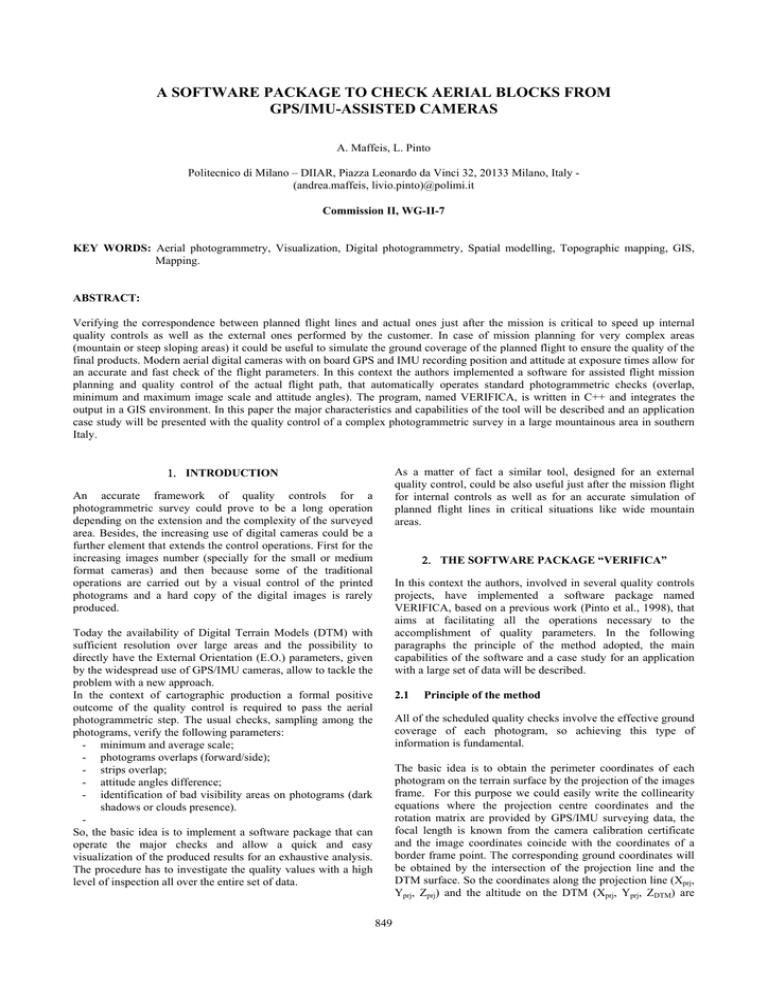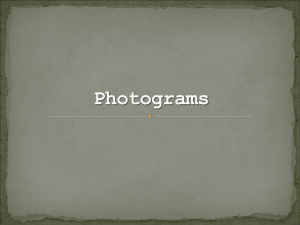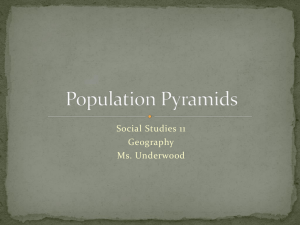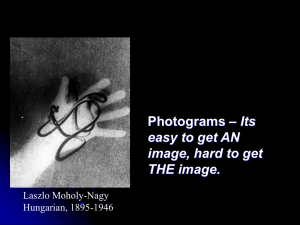A SOFTWARE PACKAGE TO CHECK AERIAL BLOCKS FROM GPS/IMU-ASSISTED CAMERAS
advertisement

A SOFTWARE PACKAGE TO CHECK AERIAL BLOCKS FROM GPS/IMU-ASSISTED CAMERAS A. Maffeis, L. Pinto Politecnico di Milano – DIIAR, Piazza Leonardo da Vinci 32, 20133 Milano, Italy (andrea.maffeis, livio.pinto)@polimi.it Commission II, WG-II-7 KEY WORDS: Aerial photogrammetry, Visualization, Digital photogrammetry, Spatial modelling, Topographic mapping, GIS, Mapping. ABSTRACT: Verifying the correspondence between planned flight lines and actual ones just after the mission is critical to speed up internal quality controls as well as the external ones performed by the customer. In case of mission planning for very complex areas (mountain or steep sloping areas) it could be useful to simulate the ground coverage of the planned flight to ensure the quality of the final products. Modern aerial digital cameras with on board GPS and IMU recording position and attitude at exposure times allow for an accurate and fast check of the flight parameters. In this context the authors implemented a software for assisted flight mission planning and quality control of the actual flight path, that automatically operates standard photogrammetric checks (overlap, minimum and maximum image scale and attitude angles). The program, named VERIFICA, is written in C++ and integrates the output in a GIS environment. In this paper the major characteristics and capabilities of the tool will be described and an application case study will be presented with the quality control of a complex photogrammetric survey in a large mountainous area in southern Italy. 1. INTRODUCTION As a matter of fact a similar tool, designed for an external quality control, could be also useful just after the mission flight for internal controls as well as for an accurate simulation of planned flight lines in critical situations like wide mountain areas. An accurate framework of quality controls for a photogrammetric survey could prove to be a long operation depending on the extension and the complexity of the surveyed area. Besides, the increasing use of digital cameras could be a further element that extends the control operations. First for the increasing images number (specially for the small or medium format cameras) and then because some of the traditional operations are carried out by a visual control of the printed photograms and a hard copy of the digital images is rarely produced. 2. THE SOFTWARE PACKAGE “VERIFICA” In this context the authors, involved in several quality controls projects, have implemented a software package named VERIFICA, based on a previous work (Pinto et al., 1998), that aims at facilitating all the operations necessary to the accomplishment of quality parameters. In the following paragraphs the principle of the method adopted, the main capabilities of the software and a case study for an application with a large set of data will be described. Today the availability of Digital Terrain Models (DTM) with sufficient resolution over large areas and the possibility to directly have the External Orientation (E.O.) parameters, given by the widespread use of GPS/IMU cameras, allow to tackle the problem with a new approach. In the context of cartographic production a formal positive outcome of the quality control is required to pass the aerial photogrammetric step. The usual checks, sampling among the photograms, verify the following parameters: - minimum and average scale; - photograms overlaps (forward/side); - strips overlap; - attitude angles difference; - identification of bad visibility areas on photograms (dark shadows or clouds presence). So, the basic idea is to implement a software package that can operate the major checks and allow a quick and easy visualization of the produced results for an exhaustive analysis. The procedure has to investigate the quality values with a high level of inspection all over the entire set of data. 2.1 Principle of the method All of the scheduled quality checks involve the effective ground coverage of each photogram, so achieving this type of information is fundamental. The basic idea is to obtain the perimeter coordinates of each photogram on the terrain surface by the projection of the images frame. For this purpose we could easily write the collinearity equations where the projection centre coordinates and the rotation matrix are provided by GPS/IMU surveying data, the focal length is known from the camera calibration certificate and the image coordinates coincide with the coordinates of a border frame point. The corresponding ground coordinates will be obtained by the intersection of the projection line and the DTM surface. So the coordinates along the projection line (Xprj, Yprj, Zprj) and the altitude on the DTM (Xprj, Yprj, ZDTM) are 849 The International Archives of the Photogrammetry, Remote Sensing and Spatial Information Sciences. Vol. XXXVII. Part B2. Beijing 2008 - a parameter file with the information about camera adopted (focal length, pixel size, frame dimension), block geometry (photograms, strips and photograms per strip numbers) and tolerance values; - a file with Exterior Orientation (E.O.) data; - a DTM Ascii file structured like Surfer DTM. The main output is always represented by a report file that contains all the check results. calculated with an iterative procedure that stops when the difference between altitudes (Zprj - ZDTM ) is lower than an input tolerance value. Applying this method for a set of points sampled along the frame border is possible to produce the corresponding ground points. With this arranged points sequence we could easily draw a polygon that represents the real ground coverage of each photogram (Figure 1). The graphical representation of the aerial blocks is an immediate and helpful tool for visualization and is the first step for numerical quality controls. As a matter of fact having the perimeter coordinates obtained with the described projection method is possible to define the surface domain for each image and to set up algorithms aiming at calculating the overlap values of consequent photograms (or strips). The algorithms are based on the comparison between ground point positions of adjacent sides for consequent photograms (in case of forward overlap) or strips (in case of side overlap). Due to the dimension of this exhaustive report file, that depends on the block dimension and could be very large, another report file is produced that contains the same information structured in a table format. In this way also wide areas quality control results can be easily read and analyzed. But the main advantage of VERIFICA is to generate a graphical file with an immediate and comprehensive visualization of the quality control results. The DXF file provides only the geometry characteristics while the GML file (FME profile) provides also the alphanumeric outcome of the quality evaluation. Frame projection This is the tool that allows a quick evidence of the ground coverage of each photogram, based on the projection over the DTM of image points regularly sampled on the frame border. For each photogram the average side (longitudinal and transversal) ground coverage is estimated and at the same time the minimum, maximum and average scale are calculated using the lowest, highest and average altitude value in the corresponding domain area. All this information together with the rotation matrix, the image and ground coordinates are given in the text report. The DXF file is built starting from the estimated ground coordinates; the GML file also reports the scale and side coverage numerical results (Figure 2). The only user choice that could influence the final output is represented by the definition of the sampling step along the frame border. This value, requested for both sides, must be indicated in the input parameter file and it is expressed in pixel numbers. It necessarily depends on the dimension and resolution of the camera frame but also depends on the surface complexity. For example in a mountain area the sampling step should be quite short (approx. 1/10 – 1/15 of the side size) whereas in flat area could be longer, even 1/3 or 1/2 of the side size. Figure 1. The projection over the DTM Another type of quality control involves the captured images contents, aiming at identifying areas where the ground details are hidden by clouds or dark shadows. In this context, due to the general approach to the main problem, the authors chose not to use the image collection for radiometric contrast analysis but only the available data used also for other checks. Obviously in this way it is not possible to highlight areas interested by cloud presence but the advantage is that it is not necessary to have the entire set of images available and it is possible to operate simulations on planned datasets. The method principles just presented were implemented by the authors in a software package named VERIFICA and in the next paragraph the main skills will be shown detailing the algorithms used, the input data required and the output data produced. 2.2 Capabilities of the software The VERIFICA software package can be usefully used in the context of photogrammetric surveying quality controls or simulations. It is structured in several modules that share the same framework, while each one carries out a different type of check. All of the modules require some basic input data recorded in plain text files: Figure 2. An example of two projected photograms 850 The International Archives of the Photogrammetry, Remote Sensing and Spatial Information Sciences. Vol. XXXVII. Part B2. Beijing 2008 Models overlap calculation This module, aiming at ensuring that the photogrammetric models can be used in stereorestitution phase, basically verifies that the forward/side overlap values between contiguous photograms respect the scheduled threshold (usually 60% and 90%, but they could be modified in the input parameters file). identified by means of the intersection between the average strip flight perpendicular line and the inferior side of strip B. The ground distance between two points represents the overlap value. The percentage value is obtained comparing the estimated value with the transversal side ground average coverage. In the forward overlap algorithm, for each photogrammetric model, only the vertices of consequent polygon sides are considered, then they are projected along the average strip flight axis and the mutual distance is calculated. The minimum value of this distance is assumed as the forward overlap value (Figure 3). By comparing it with the longitudinal side ground average coverage, the percentage value is obtained. The output consists of a text file with the check results and a GML file representing the overlap segments. In the attribute table of the GML output file, the overlap values (in meters and in percentage) for each segment are contained. Least square strip axis estimation This module simply produces a report text file with the strips flight axis parameters equations. The equation is obtained by a least square estimation from the ground projection principal points of each strip. Similarly, the side overlap is estimated starting from the vertices of the flight parallel photogram sides and the distance is calculated along a line perpendicular to the average axis. Also the distance between each principal point and the estimated axis is calculated. A text and a table report (a row for each model) are produced with general information for the model (strip/photograms ID, average scale, base length) and the results of the evaluations. Stereo-visibility tools Moreover a GML file is produced: for each photogram geometry the check results regarding the corresponding models are recorded. The GML file also has two fields (“Longitud” and “Transv”) with binary values containing for each record (model) the pass/no pass test result. With this tool it is possible to identify in how many photograms a ground point (or a set of ground points) is visible. The method is based on the same principle of the frame projection, but from a reverse point of view. Having the ground coordinates of a point, the image coordinates of each photogram in which the ground point is visible are estimated by the collinearity equations. The output is a text file containing the ground coordinates and the corresponding image coordinates of each photogram in which the point is visible. Dark area identification This module is used to check the images quality using only the same input of other modules. One of the image problems encountered during an aerial photogrammetric survey is the presence in the photograms of dark areas that do not allow a correct vision of ground details. Knowing the position (Latitude and Longitude) of a point it is possible to calculate the elevation and azimuth of the sunbeams at any moment and date (Meeus, 1998). So, the algorithm implemented considers for each photogram, a part from the E.O. values, also the exposure date and time and estimates the sun position at that moment. Figure 3. The forward overlap In addition to model overlaps controls, it is fundamental that the adjacent photograms attitude angles (ω, φ, κ) do not have large variations. So in this module, that considers every model, the angles differences are calculated and they are reported both in text and graphical files. This value becomes the input parameter for the subsequent procedure that identifies the dark areas. For each photogram a set of ground points regularly sampled on a grid over the ground image domain (the grid step is assumed as ½ of the DTM spatial resolution) are considered. The algorithm computes the line having the corresponding elevation / azimuth values and passing by each ground point. If the line intersects the DTM in another point it means that the sunbeams do not hit the grid node and that the path line between the two points gives rise a dark area. So, a 3D line is written in the GML output file for each point that results in a shadow area. As an attribute for the line feature, also a negative value of the altitude difference between line and DTM is given which represents the magnitude of the darkness. Strips overlap calculation The purpose of this tool is to verify the side overlap between contiguous strips. To ensure the quality accomplishment, the minimum overlap value should be larger than the scheduled threshold (usually 10%). The procedure uses, for each couple of strips, all the vertices of the adjacent sides (superior or inferior side) that are visible at least on two photograms. The overlap values are considered along a line perpendicular to the average strip flight axis. So, considering two strips (A and B), for each vertex of the superior side of each photogram of strip A, a corresponding point is Moreover a text file containing the number of dark points for each photogram is produced as output. 851 The International Archives of the Photogrammetry, Remote Sensing and Spatial Information Sciences. Vol. XXXVII. Part B2. Beijing 2008 VERIFICA with 20 m and 100 m DTM are shown. In table 1 the two sets of results are compared. To demonstrate the accuracy of the procedure, the results of a synthetic example are presented in Figure 4. It was supposed to have a single image interesting an high mountain area. The exposure time was fixed at 11:05 of 18 March 2008. Frame ground size HILLSHADE dark areas VERIFICA dark areas Dark areas not identified DTM resolution 20 m 100 m 20 m 100 m 20 m 100 m 20 m 100 m Pixels 17385 751 2179 77 34 1 Surface (m2) 6954000 7510000 871600 770000 1257866 398593 13600 10000 % 12.5 10.2 18.1 5.3 0.2 0.1 Table 1. Comparing results obtained using different DTM Figure 4. A 3D view of a synthetic example for dark areas identification using a 20 m DTM Due to the exposure position and time the azimuth and elevation values result respectively equal to 152°.11 and 39°.81. From the 20 m x 20 m DTM and the estimated sun position values the corresponding hillshade surface is obtained, by ArcGIS Spatial Analyst, where the pixel value indicate the darkness level. Figure 5. A 2D view of the same example of Fig. 4 using a 100 m DTM Beside with the VERIFICA tools the dark area path lines and the frame projection polygon are obtained. By a simple visual comparison a good matching between the hillshade surface and the VERIFICA output (Fig. 4 and Fig. 5) results. In this context the tool proved to be useful in case of an aerial block composed by a large set of photograms taken in different periods, because it is immediately possible to verify that the sunbeams elevation minimum value is everywhere accomplished and dark areas are absent. Moreover the same tool could be helpful in the planning phase: in case of a large survey in mountainous areas it allows a precise simulation of the conditions that could be met. 2.3 Output results in GIS Environment An advantage of this approach to photogrammetric survey quality controls is the possibility to verify the accomplishment of several quality parameters just after the flight mission and specially to manage the numerical check results together with a graphical representation in a GIS environment. In the previous paragraph we have seen that for each of the main tools a GML file (FME profile) is produced that allows an easy and immediate visualization of the quality control results. In particular, the GML files are: Frame projection: the geometry is polygonal and each entity represents the effective ground coverage of the frame. The attributes provide information about the photogram and strip ID, the minimum/maximum and average scale and the minimum/maximum and average ground resolution. Photograms overlap: the geometry is polygonal and for each model a set of information resulting by the check algorithm is given like photograms ID, base heights, average κ angle, forward overlap values, side overlap values, attitude angles differences. Strip overlap: the features have line geometry and describe the side strip overlap at sampled points. In the attribute table the value of the estimated side overlap (in meters and in percentage) is contained. Dark area identification: the 3D line features having the same elevation and azimuth angles of sun position at that moment represent the effective path of sunbeams. An extreme vertex is a sampled point and the other one Aiming at verifying the dependence of the tool from the spatial resolution of the input DTM, the same data of the previous example were used with a 100 m x 100 m DTM and the results were compared with the results obtained using the 20 m x 20 m DTM. With a lower resolution DTM it be expected worse identification of the dark areas. With ArcGIS Spatial Analyst the hillshade surface for each DTM are obtained. As reference values of dark areas the number of pixels (and the corresponding areas) are considered, with value “0” in the hillshade raster. The envelope areas of the feature lines produced by VERIFICA were calculated and they are been compared with reference values. Moreover, aiming at evaluating the quantity of dark areas not identified by VERIFICA, the number of pixels in reference dataset that are not covered by any lines produced by VERIFICA were estimated. In Figures 4 and 5 the different outputs of 852 The International Archives of the Photogrammetry, Remote Sensing and Spatial Information Sciences. Vol. XXXVII. Part B2. Beijing 2008 The flight lines plan designed by the firm divides the entire area in three different zones that should been covered by different flight missions: areas with surface altitude lower than 600 meters are surveyed by flight lines with an average altitude of 2700 meters (“2700 mission”); areas with surface altitude between 600 and 1400 meters are surveyed by flight lines with an average altitude of 3300 meters (“3300 mission”); areas with surface altitude upper than 1400 meters are surveyed by flight lines with an average altitude of 3400 meters(“3400 mission”). This approach produced the acquisition of an enormous number of images (over 8000). coincides with DTM intersection. So, the areas in each ground frame domain interested by insufficient lighting are covered by a line set. The line density depends on the sampling step. The photogram ID, the elevation and azimuth angles and the altitude difference between DTM and sunbeams at intersection point are recorded as attribute. In case of absence of dark areas the output is an empty GML file. In this way with the VERIFICA outputs and some basic GIS instruments everyone may have a comprehensive outlook over the real survey, focusing on the quality accomplishment. Figure 6. The analysis of VERIFICA results performed in ArcGIS environment Figure 7. The planned flight lines at the different altitudes 3. CASE STUDY The flight mission started in Autumn 2006. Due to the complexity of the project and meteorological adversity the mission suffered several problems that caused delays. So, the mission finished in late Summer 2007, and the quality control operations were performed in Autumn 2007. The case study presented here is an example of application of the software to real data. The cartographic centre of Calabria Region has planned to realize the 1:5000 Topographic Map in 9 lots. The formal quality control for a block of 3 lots was assigned to DIIAR – Politecnico di Milano and is actually carried out by the authors. Calabria region is in the south-west extreme of the Italian peninsula and is interested by a high mountain system close to coastal lines. All of the recorded images were accompanied by the attitude angles and the position of the centre of projection at the exposure time, given by on board APPLANIX system. At the end of the flight operations the firm deliverable at Politecnico di Milano for the formal quality control evaluation: the list of effective projection centres coordinates and the respective attitude angles for each mission (2700 m, 3300 m and 3400 m); the entire set of acquired images in the original format and their thumbnails; digital camera and IMU/GPS calibration parameters. Below the methodology applied and the results of the quality control on the area of three lots analyzed are presented. The surveying area is characterized by an extension of about 6000 Km2, the altitude varies from 0 to 2200 meters and the slopes reach 50 degrees. The commissioned firm chose to use a medium format digital camera: the DMC Z/I Imaging that has a frame size of 13824 x 7680 pixels (corresponding of an image size of 16.6 x 9.2 cm2). All these elements give an idea of the complexity of the general project and primarily of the aerial survey. Using the VERIFICA package the authors carried out the set of scheduled controls requested by the customer (Calabria Region). The first step was the projection of the frames on the DTM and the check of the accomplishment of the scale range. Due to the different elevation flight lines and the consequent overlaps of some frames, the analysis of the VERIFICA results 853 The International Archives of the Photogrammetry, Remote Sensing and Spatial Information Sciences. Vol. XXXVII. Part B2. Beijing 2008 was crucial. Some problematic models of a single flight mission automatically identified by the software often interested an area covered by major elevation flight lines. Total strips Couple of strips Photograms Average value Couple of strips Photograms Average value Critical Problems For example in Figure 8 for a small area of “2700 mission” the photograms (in purple) that do not respect the forward overlap value (60%) are shown. As a matter of fact the majority of the problematic models obtained from the VERIFICA procedure intersect the 600 meters contour line. In the context of this quality control it was necessary to verify if those problematic areas were covered by other models, in order not to be considered critical. The results highlight that although in each mission there were some problematic models that did not accomplish the overlap value, analyzing all the missions no model can be really considered critical. Numbers of models 4471 1557 522 Problematic models 248 145 56 Missions 3300 m 66 3400 m 21 6 12 2 40 200 14 9.3 3.9 8.8 2 10 2 12 176 14 9.7 3.0 8.8 Table 3. Numerical results of side overlap check Figure 8. An example of the results of forward overlap check (the problematic models are shown in purple and the black line represents the 600 meters contour line) for the “2700 mission”. Mission flight “2700 m” “3300 m” “3400 m” 2700 m 119 Figure 9. An example of the results of the forward overlap check (in red the segment that identify critical overlap values) for the “3300 mission”. In conclusion, a traditional approach to quality control applied to this aerial survey would be excessively onerous and probably would not identify all the problems. So, the VERIFICA package proved to be a precious help and support in the entire quality control procedure. Moreover the easy handling and visualization of the quality results in an ordinary GIS environment allowed the necessary analysis from a critical point of view. Critical models 0 0 0 Table 2. Numerical results of forward overlap check On the other hand, more serious problems were identified during the side strip overlap controls. As a matter of fact the authors encountered a lot of problematic situations where the side overlap value (10%) is not accomplished and some of these problems are not balanced by overlapping models of others missions. In Table 3 a brief report of the problematic and critical situations encountered for each mission is given. In Figure 9 a representation of the side overlap segments for one of the most critical areas for the “3300 mission” is shown. 4. CONCLUSIONS The direct representation in a GIS environment is fundamental for a critical analysis of the outputs of automatic checks. Overlaying the VERIFICA layers and project layers (i.e. boundary of surveyed area, contours, etc.) allows to analyze the results and to identify those critical models that cannot be accepted in terms of quality. 854 The International Archives of the Photogrammetry, Remote Sensing and Spatial Information Sciences. Vol. XXXVII. Part B2. Beijing 2008 Meeus, J., 1998. Astronomical Algorithms. Willmann-Bell Inc., Richmond. The quality control with traditional methods would be very hard to perform, but the intensive use of the software VERIFICA easily allows to identify some critical situations where the quality parameters were not respected. ACKNOWLEDGEMENTS This work has been financed in the framework of the National Research Program COFIN 2006 by the Ministry of the University and Scientific Research of Italy. Thanks go to prof. F. Sansò of Politecnico di Milano for coordinating the project. The authors wish to thank dr. Tonino Caracciolo and dr. Vincenzo Marra, heads of Cartography Centre of Regione Calabria, for providing flight mission data. REFERENCES Barilli M., Forlani G., Pinto L., 1998, Automatic design and checks for aerial photogrammetrics surveys. In: Bollettino della SIFET , n° 1/98, pp. 81-95. 855 The International Archives of the Photogrammetry, Remote Sensing and Spatial Information Sciences. Vol. XXXVII. Part B2. Beijing 2008 856





